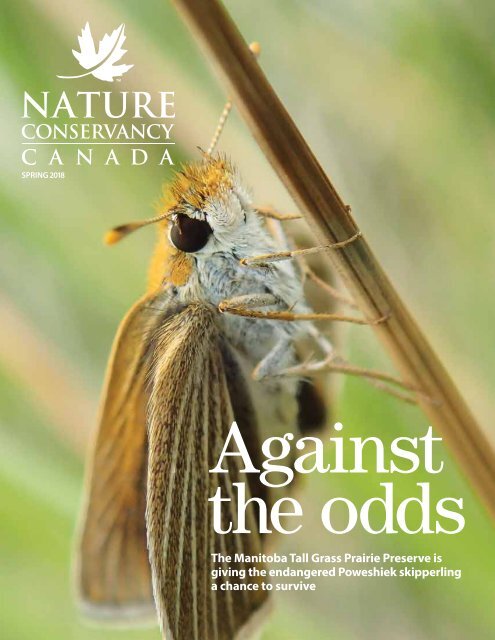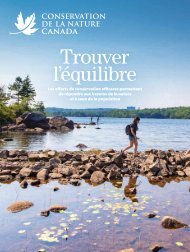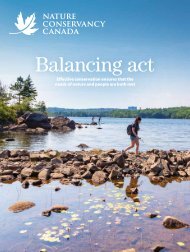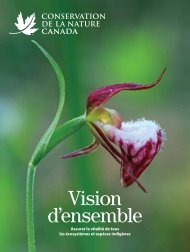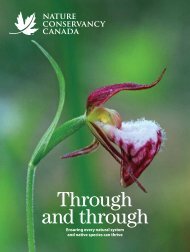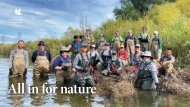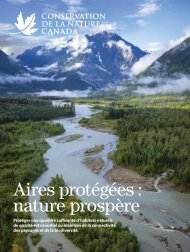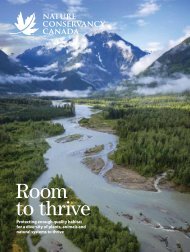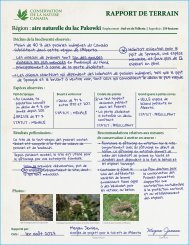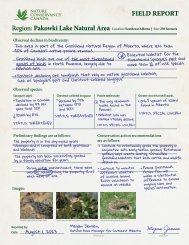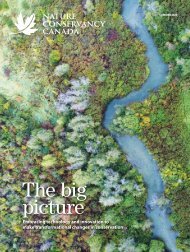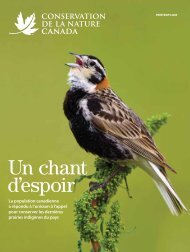Spring 2018 NCC Magazine
You also want an ePaper? Increase the reach of your titles
YUMPU automatically turns print PDFs into web optimized ePapers that Google loves.
SPRING <strong>2018</strong><br />
Against<br />
the odds<br />
The Manitoba Tall Grass Prairie Preserve is<br />
giving the endangered Poweshiek skipperling<br />
a chance to survive
Nature Conservancy of Canada<br />
SPRING <strong>2018</strong><br />
Nature Conservancy of Canada<br />
245 Eglinton Ave. East, Suite 410<br />
Toronto, Ontario, Canada M4P 3J1<br />
magazine@natureconservancy.ca<br />
Phone: 416.932.3202<br />
Toll-free: 800.465.0029<br />
The Nature Conservancy of Canada (<strong>NCC</strong>)<br />
is the nation’s leading land conservation<br />
organization, working to protect our most<br />
important natural areas and the species<br />
they sustain. Since 1962, <strong>NCC</strong> and its partners<br />
have helped to protect 2.8 million acres (more<br />
than 1.1 million hectares), coast to coast.<br />
The Nature Conservancy of Canada <strong>Magazine</strong> is<br />
distributed to donors and supporters of <strong>NCC</strong>.<br />
TM<br />
Trademarks owned by the Nature Conservancy<br />
of Canada.<br />
FSC is not responsible for any calculations<br />
on saving resources by choosing this paper.<br />
Printed on Rolland Opaque paper, which<br />
contains 30% post-consumer fibre, is<br />
EcoLogo, Processed Chlorine Free certified<br />
and manufactured in Canada by Rolland<br />
using biogas energy. Printed in Canada with<br />
vegetable-based inks by Warrens Waterless<br />
Printing. This publication saved 29 trees and<br />
104,292 litres of water*.<br />
Design by Evermaven.<br />
COVER<br />
Poweshiek skipperling<br />
Photo by Rachel Caro.<br />
THIS PAGE<br />
Western prairie white-fringed orchid,<br />
Tall Grass Prairie Preserve, MB<br />
Photo by Thomas Fricke.<br />
GENERATED BY: CALCULATEUR.ROLLANDINC.COM<br />
*<br />
2 SPRING <strong>2018</strong> natureconservancy.ca
Contents<br />
Nature Conservancy of Canada SPRING <strong>2018</strong><br />
Helping hands<br />
TKTKTKTKTKTKT<br />
THOMAS FRICKE. BRENT CALVER. ROBERT MCCAW.<br />
There’s always something new to learn<br />
about the natural world when you work<br />
for a conservation organization. While<br />
producing the spring <strong>2018</strong> issue of the Nature<br />
Conservancy of Canada <strong>Magazine</strong>, for instance,<br />
I learned that 800 migratory bird species benefit<br />
from laws set in place more than 100 years ago<br />
by Canada and the U.S.<br />
Each spring, as many of these species return<br />
to Canadian soil to breed and nest, Conservation<br />
Volunteers for the Nature Conservancy of Canada<br />
(<strong>NCC</strong>) travel to <strong>NCC</strong> properties from coast to<br />
coast. Volunteers of all ages lend a hand to help<br />
ensure these properties are safe and in good<br />
condition for the birds’ arrival. You can be a part<br />
of those efforts by signing up for an event at<br />
conservationvolunteers.ca.<br />
In this issue, you’ll also read about our efforts<br />
to protect habitat for globally rare species at<br />
risk, such as the Poweshiek skipperling butterfly.<br />
Once a common species, there are now fewer<br />
Poweshieks than pandas; scientists are in a race<br />
against the clock to understand why it is declining.<br />
In our Force for Nature story, we introduce<br />
you to ranchers Scott and Julia Palmer, who<br />
talked to us about their connection to the land<br />
and the impact of their conservation agreement<br />
with <strong>NCC</strong>. And find out how citizen scientists<br />
in Quebec can now be a part of helping turtle<br />
species, such as the snapping turtle.<br />
As the snow melts in coming weeks and signs<br />
of spring begin to emerge, we encourage you to<br />
share your first signs of spring with us. You’ll find<br />
more information on our #<strong>NCC</strong>EarlyBirds photo<br />
contest on page 5 of this issue.<br />
Thank you as always for your support of<br />
our work.<br />
Yours in conservation,<br />
CBT<br />
Christine Beevis Trickett<br />
Director, Editorial Services<br />
8<br />
12<br />
14 For the birds<br />
Honour the Convention for the<br />
Protection of Migratory Birds by<br />
helping to protect Canada’s habitats.<br />
16 Big heart country<br />
The Creemore Nature Preserve brings<br />
together locals in a shared passion<br />
for the natural gem in their backyard.<br />
17 Magic fabric<br />
Outdoor educator Jackie Pye never<br />
forgets to take her Indonesian<br />
sarongs into the great outdoors.<br />
18 Hidden in plain sight<br />
Giving the Poweshiek skipperling<br />
a chance to survive in Manitoba at<br />
the Tall Grass Prairie Preserve.<br />
14<br />
12 Snapping turtle<br />
Built like armoured tanks, with their<br />
mighty jaws and muscular build, these<br />
are Canada’s largest freshwater turtles.<br />
14 Project updates<br />
Protecting the island home of a nationally<br />
rare shrub, ensuring a family’s natural<br />
legacy and honouring one man's efforts.<br />
16 Home on the range<br />
When it comes to tending to the cattle<br />
and land on Palmer Ranch in southwestern<br />
Alberta, it’s all in the family.<br />
18 A chance to thrive<br />
Senator Diane Griffin recalls a memorable<br />
encounter with a Thomson’s gazelle while<br />
on safari in Africa.<br />
natureconservancy.ca<br />
SPRING <strong>2018</strong> 3
COAST TO<br />
COAST<br />
For the birds<br />
Celebrate the protection of more than 800 species<br />
of migratory birds by volunteering to help protect<br />
Canada’s habitats<br />
Over the last century, a number of legal agreements signed by Canada<br />
and the U.S. have helped protect more than 800 species of migratory<br />
birds. In 1916, both countries signed the Convention for the Protection<br />
of Migratory Birds, which aims to stop the indiscriminate and commercial<br />
hunting of migratory birds and protect their nesting sites.<br />
Last year marked the 100-year anniversary of Canada’s Migratory<br />
Birds Convention Act, and <strong>2018</strong> is the centennial of the U.S. Migratory<br />
Bird Treaty Act. All three are among important migratory bird conservation<br />
efforts in North America over the last century.<br />
You can help lend a hand to manage and restore habitat for migratory<br />
birds by becoming a Conservation Volunteer.<br />
Show your love!<br />
Join a community of Canadians<br />
working to protect species and<br />
natural habitats. Like they say,<br />
birds of a feather flock together!<br />
conservationvolunteers.ca<br />
ISTOCK.<br />
TKTK<br />
4 SPRING <strong>2018</strong> natureconservancy.ca
SONGBIRDS<br />
Restore and care<br />
for bird habitat<br />
ILLUSTRATIONS: LAURA FETTERLEY. PHOTO: <strong>NCC</strong>.<br />
RAPTORS<br />
Become a<br />
citizen scientist<br />
Raptors, or birds of prey, are<br />
species that hunt and feed<br />
on other animals, including<br />
rodents and birds. They have<br />
keen eyesight, hooked beaks,<br />
and feet with sharp, curved<br />
claws or talons. The group<br />
includes falcons, ospreys,<br />
hawks, vultures and eagles.<br />
Last year, <strong>NCC</strong> volunteers<br />
observed migrating golden<br />
eagles during an event in<br />
Alberta’s Crowsnest Pass. They<br />
also learned about raptors<br />
from local experts. In British<br />
Columbia, volunteers have<br />
helped conduct bird inventories<br />
to inform the development<br />
of <strong>NCC</strong>’s conservation plans.<br />
You can sign up for one of<br />
<strong>NCC</strong>’s bird inventories across<br />
the country and learn more<br />
about birds of prey like the<br />
golden eagle. Apply that<br />
knowledge by downloading<br />
eBird or iNaturalist — two<br />
fantastic citizen science apps<br />
— and heading out to the field<br />
to collect important bird data.<br />
You’ll be contributing to a<br />
collective body of information<br />
on birds.<br />
GRASSLAND BIRDS<br />
Make fences<br />
safer for birds<br />
Hollow metal posts are often<br />
used in fences on Canada’s<br />
prairies. Since they are small<br />
in diameter and have smooth<br />
inside walls, the posts can<br />
create an unintended hazard<br />
for grassland songbirds. Birds<br />
can become trapped when<br />
they are looking for a hole to<br />
nest in, or when they perch at<br />
the edge of the uncapped post<br />
to explore what’s inside. Young<br />
birds are especially at risk,<br />
since they can easily fit into<br />
pipes. Once they are trapped,<br />
there is no way for them to<br />
climb out, and they die.<br />
The most critical times for birds<br />
getting caught in these hollow<br />
pipes is during migration and<br />
breeding seasons, when more<br />
birds are present and searching<br />
for shelter and homes. You can<br />
show your support for grassland<br />
songbirds, like McCown’s<br />
longspur, by helping <strong>NCC</strong> staff<br />
cap fence posts with tin cans<br />
and other recycled materials<br />
at the Old Man on His Back<br />
Prairie and Heritage Conservation<br />
Area in Saskatchewan.<br />
SHOREBIRDS<br />
Keep Canada’s<br />
shorelines clean<br />
Shorebirds sport long legs for<br />
wading in water or on mudflats,<br />
and long bills for feeding on<br />
hidden invertebrates. This group<br />
includes oystercatchers, avocets,<br />
stilts, turnstones, sandpipers,<br />
yellowlegs, snipes, godwits,<br />
curlews, phalaropes and plovers.<br />
The piping plover is an iconic<br />
yet endangered shorebird. In<br />
Atlantic Canada it breeds on<br />
sand and pebble beaches.<br />
You can support piping plovers<br />
and other shorebird species<br />
by participating in a shoreline<br />
cleanup this year. By volunteering<br />
to clean up marine debris<br />
and litter, you’ll enhance shoreline<br />
health and protect the areas<br />
where these birds nest and feed.<br />
<strong>NCC</strong> hosts several shoreline<br />
cleanups each year, such as at<br />
Holman’s Island in PEI, Brier<br />
Island in Nova Scotia and Sandy<br />
Point beach in southwest<br />
Newfoundland.<br />
Songbirds, such as the<br />
endangered prothonotary<br />
warbler, are perching birds<br />
known for their diverse<br />
and elaborate songs. Many<br />
songbirds, including chickadees,<br />
woodpeckers, finches and<br />
nuthatches, are often seen at<br />
winter feeders. Sadly, many<br />
songbirds are disappearing,<br />
largely due to habitat loss.<br />
Join efforts to restore and<br />
maintain the health of native<br />
bird habitat by volunteering for<br />
a restoration project this year.<br />
Whether it’s digging in for<br />
a weed pull to remove invasive<br />
plants or rolling up your sleeves<br />
to plant a tree, you can help<br />
ensure songbirds continue to<br />
have safe places to nest and<br />
rear their young.<br />
In Ontario, <strong>NCC</strong>’s Conservation<br />
Volunteers have been supporting<br />
restoration work on Pelee<br />
Island — a site well known for<br />
its spring songbird migration<br />
— for more than eight years.<br />
This includes collecting seeds<br />
and planting native species on<br />
the property’s meadows and<br />
restored wetlands, creating<br />
prime habitat for birds.1<br />
Celebrate the return of migratory birds with<br />
<strong>NCC</strong>’s First Signs of <strong>Spring</strong>: Early Bird Edition<br />
photo contest, now until May 1. Snap these<br />
moments and share your photos on our<br />
Facebook gallery or on Twitter and Instagram<br />
using #<strong>NCC</strong>EarlyBirds. You could win one of<br />
our weekly outdoor gear prizes or even the<br />
grand prize: a $1,000 gift card. Upload your<br />
photos and vote for your favourites today!<br />
#<strong>NCC</strong>EarlyBirds<br />
natureconservancy.ca
BOOTS ON<br />
THE TRAIL<br />
Big heart country<br />
The Creemore Nature Preserve brings together locals<br />
with a shared passion for a natural gem in their backyard<br />
Creemore Nature Preserve<br />
Two hours northwest of downtown<br />
Toronto is the small Ontario town<br />
of Creemore, home to the Nature<br />
Conservancy of Canada’s (<strong>NCC</strong>’s) Creemore<br />
Nature Preserve. This 204-acre (83-hectare)<br />
property is loved by both locals and<br />
visitors alike.<br />
Home to majestic, mature sugar maple<br />
trees, a meandering, coldwater stream and<br />
small pockets of wetlands, this lush Niagara<br />
Escarpment forest shelters a variety of rare<br />
and at-risk species. The sounds of hairy and<br />
pileated woodpeckers echo through the trees,<br />
while the red-shouldered hawks soar in the<br />
skies above. At-risk wood thrushes and<br />
eastern wood-pewees also live here. The<br />
restored streams on the property support<br />
trout and other coldwater fishes, as well<br />
as various frogs and turtles.<br />
WILD WALK<br />
Over the years, <strong>NCC</strong> staff, along with volunteers,<br />
have installed new footbridges and<br />
improved trails on the reserve to provide<br />
recreational access for hikers and protect the<br />
surrounding habitat. There is a connected<br />
network of hiking trails that vary in difficulty<br />
and length, all of which have interpretive<br />
signage explaining the natural history and<br />
features of the area.<br />
As you walk through the forest and along the<br />
banks of the stream, you might spot the flash of<br />
silver from a jumping trout. Take the 100-metre<br />
Lookout Trail to see a former pond that is<br />
in the process of transforming into a marsh<br />
surrounded by new willows and dogwoods.<br />
Go early in the morning or in the late afternoon<br />
and you might spot a deer or coyote.<br />
LOCAL LOVE<br />
Known locally as “the Mingay,” after the family<br />
who originally owned and donated the land<br />
to <strong>NCC</strong>, the Creemore Nature Preserve is an<br />
important part of the community. This area<br />
was long inhabited by both Indigenous<br />
<strong>NCC</strong>.<br />
6 SPRING <strong>2018</strong> natureconservancy.ca
peoples and more recent settlers. <strong>NCC</strong> started<br />
working on the property in 1997, but the trails<br />
through the forest were already well known<br />
to local nature enthusiasts. Creemore comes<br />
from the Gaelic “Croí Mór,” meaning “big<br />
heart,” and the town is true to its name in<br />
supporting and caring for this important local<br />
natural gem.<br />
Several partners have supported <strong>NCC</strong>’s work<br />
at the Creemore Nature Preserve, including<br />
Creemore <strong>Spring</strong>s Brewery, Nottawasaga Valley<br />
Conservation Authority, Fisheries and Oceans<br />
Canada, Gail Worth, Ian Cook and Carol Phillips,<br />
Bruce and Anne Godwin, DJ and Diane Wiley,<br />
and the Dichek family, in addition to many<br />
local families and the Government of Canada,<br />
under the Natural Areas Conservation Program.<br />
BACKPACK<br />
ESSENTIALS<br />
White trillium<br />
TRILLIUM: <strong>NCC</strong>. SARONGS: JUAN LUNA.<br />
TRAILS<br />
Maple Leaf Loop | moderate<br />
Length: 2.5 km Width: 1–3 m<br />
Surface: hard-packed dirt and rolling hills<br />
Highlights: Venture through a mature sugar<br />
maple forest and over stream crossings on<br />
this trail loop.<br />
Mingay Trail | moderate<br />
Length: 2.5 km Width: 1–3 m<br />
Surface: hard-packed dirt and rolling hills<br />
Highlights: Follow the trail to a restored<br />
stream and enjoy views from the lookout.<br />
Lookout Trail | easy<br />
Length: 0.1 km Width: 0.5 m<br />
Surface: hard-packed dirt and flat ground<br />
Highlights: Visit a restored pond to see new<br />
wetland plants, such as willows and dogwoods,<br />
grow and mature.<br />
Trout Trail | easy<br />
Length: 0.5 km Width: 0.5 m<br />
Surface: hard-packed dirt and flat ground<br />
Highlights: Follow the banks of a coldwater<br />
stream, keeping an eye out for trout.1<br />
Magic fabric<br />
Her beautiful and practical Indonesian sarongs are<br />
the most useful items that outdoor educator Jackie<br />
Pye takes into the great outdoors<br />
Sometimes, the simplest things<br />
go a long way when you<br />
are in the woods.<br />
Whether camping, hiking<br />
or canoeing, there are<br />
a few tools that I never<br />
leave behind — some<br />
of them technical, and<br />
some of them practical.<br />
On the practical side,<br />
some of the most useful<br />
things in my kit have been the<br />
sarongs I have collected in my work in<br />
Indonesia at the Green School. These<br />
affordable, reusable, multiuse fabrics<br />
serve not only as a wrap for<br />
a post-dip cover-up, but have<br />
many magical uses that<br />
make them a must-have<br />
on the trail. Some of my<br />
top uses for a sarong<br />
have been: as a blanket,<br />
an emergency sling,<br />
a sun shelter, a satchel<br />
bag, a strainer (for coffee<br />
or pasta), a blindfold for trust<br />
games, a towel, a belt, a scarf<br />
and an oven mitt.1<br />
natureconservancy.ca<br />
SPRING <strong>2018</strong> 7
Hidden in plain<br />
TKTKTKTKTKTKT<br />
TOP: RACHEL CARO. BOTTOM: THOMAS FRICKE.<br />
8 SPRING <strong>2018</strong><br />
natureconservancy.ca
With perhaps only 500 Poweshiek<br />
skipperlings left in the world, the<br />
Manitoba Tall Grass Prairie Preserve<br />
is giving this endangered butterfly<br />
a chance to survive the odds<br />
sight<br />
BY Susan Peters, writer and editor<br />
TKTKTKTKTKTKT<br />
They may be drab-brown<br />
and no bigger than a<br />
loonie, but Poweshiek<br />
skipperlings are rarer<br />
than pandas.<br />
On a sunny November day, Marika Olynyk checks the<br />
temperature above and below the snow at the Manitoba<br />
Tall Grass Prairie Preserve, just 80 kilometres southeast of<br />
Winnipeg. “Oh, that’s interesting,” she says. “It’s nine degrees warmer<br />
under the snow, close to the ground.” The site is home to some of the<br />
world’s last Poweshiek skipperlings, an endangered butterfly species<br />
currently in diapause — the insect equivalent of hibernation — and<br />
protected from the cold under a quilt of snow. “We think they’re near<br />
the soil. Some insects go into the soil in winter, but we don’t think the<br />
Poweshieks do that.”<br />
The “we think” is important. In the entire world, perhaps 500 Poweshiek<br />
skipperlings are left, with a significant portion found at the Manitoba<br />
Tall Grass Prairie Preserve. Once a common species, they’ve now become<br />
exceedingly rare: 10 per cent of the world’s population may be lying,<br />
frozen, a few feet from Olynyk’s weather monitoring station. Over the<br />
past 20 years, the population took a sharp, worrisome nosedive.<br />
Determining why the butterflies have disappeared, and how they<br />
can be recovered, is a team effort that stretches across the Canada–U.S.<br />
border, requiring universities, zoos, governments and researchers, including<br />
the Nature Conservancy of Canada (<strong>NCC</strong>), to pool their knowledge, filling<br />
in the questions on this understudied species.<br />
“That’s the problem with endangered insects: they’re not on anyone’s<br />
radar. They’re fascinating if you see them up close, but no one’s going to<br />
see them up close,” says Olynyk wryly. She grew up in the country outside<br />
of Saskatoon, surrounded by nature — from the toad that came out of<br />
the sandy soil to plop onto the family’s deck when it rained, to the prairie<br />
cactus she loved showing off to a visiting relative. Passionate about<br />
natureconservancy.ca<br />
SPRING <strong>2018</strong> 9
ecosystems, Olynyk originally studied environmental<br />
science, before earning her master’s<br />
degree in natural resources management.<br />
Now an engagement coordinator in <strong>NCC</strong>’s<br />
Manitoba office, her work includes research<br />
on the Poweshiek skipperling. “They’re not as<br />
charismatic as panda bears or polar bears,<br />
although those are great for drawing attention<br />
to environmental issues.” Poweshieks also<br />
don’t have marathon flights like monarchs,<br />
those magnificent long-range flyers found<br />
across southern Canada. So it’s perhaps<br />
less easy to admire the small, drab-brown<br />
Poweshieks, which are born and die in the<br />
same small patch of prairie.<br />
Last summer, Olynyk spent three weeks<br />
observing the Poweshieks, noting everything<br />
they did: observing what nectar plants the<br />
adults feed on (black-eyed Susans are a<br />
favourite), what they do in the rain (stop<br />
flying), how far they can fly (not far) and<br />
where they mate and lay eggs (Olynyk believes<br />
the perfect spot is between slightly drier<br />
terrain, where the nectar plants used by adults<br />
grow, and the slightly wetter land that supports<br />
the plants eaten by the caterpillars).<br />
Today, Olynyk is installing a new weather<br />
monitor and camera, and checking that the<br />
other instruments are functioning correctly.<br />
The camera, normally used to photograph<br />
wildlife like deer, will instead take a daily<br />
photo of the snow against a metrestick, to<br />
track its depth as winter progresses.<br />
Established in 1989, the Manitoba Tall Grass Prairie Preserve is home to<br />
16 species at risk. Unfortunately, 99 per cent of this habitat has been lost.<br />
Today, the most urgent conservation<br />
Poweshiek skipperling, is to protect<br />
Protecting the prairie<br />
Once common across the American Midwest<br />
and adjacent Manitoba, Poweshieks are<br />
now found near Flint, Michigan, possibly in<br />
Wisconsin and in one place in Canada: the<br />
Manitoba Tall Grass Prairie Preserve. The<br />
preserve is over 12,000 acres (4,800 hectares),<br />
and owned by <strong>NCC</strong> and other partner organizations.<br />
The wind blows across flat, scrubby<br />
fields, interrupted by woods of bur oak and<br />
aspen. Here and there are old tractor attachments,<br />
abandoned by settlers who tried to<br />
grow crops, only to find the soil better suited to<br />
raising cattle. Ranchers and farmers conserved<br />
the native prairies in the area through grazing,<br />
haying and pasture-rejuvenating fire, to the<br />
delight of botanists who went looking for<br />
examples of tall grass prairie a century later.<br />
Established in 1989, the Manitoba Tall<br />
Grass Prairie Preserve is home to 16 species<br />
at risk, including two endangered butterflies:<br />
the spectacular monarch butterfly and the<br />
drab Poweshiek skipperling.<br />
With close to 200 Canadian species at risk<br />
documented on its properties, <strong>NCC</strong> is actively<br />
working to protect and recover these species.<br />
<strong>NCC</strong> also manages and restores habitats for<br />
species at risk on some properties, with<br />
activities such as prescribed fires and invasive<br />
plant control.<br />
<strong>NCC</strong> also works with local conservation<br />
groups and other landowners to develop<br />
management plans for properties. In the<br />
Manitoba Tall Grass Prairie Preserve, for<br />
example, cattle grazing and haying the<br />
grasses can help maintain open grasslands,<br />
benefitting the health of the prairie and<br />
local economy alike.<br />
“Canada has this very long history of<br />
recovering rare species, such as swift fox,<br />
white pelican and bald eagle,” notes Dan<br />
Kraus, <strong>NCC</strong>’s senior conservation biologist,<br />
adding that there have been three main<br />
causes of wildlife loss in Canada over the<br />
last 150 years: unsustainable harvest,<br />
pollution (such as DDT) and habitat loss.<br />
“We’ve made good progress on the first two<br />
problems,” says Kraus. “Today, the most<br />
urgent conservation action for species at<br />
risk is to protect and restore their habitats.”<br />
Tall grass prairies and the species that<br />
live there are in trouble, says Kraus. “We’ve<br />
lost 99 per cent of this habitat, and it’s<br />
critical we save what’s left.”<br />
CLOCKWISE, TOP RIGHT: JIM BRANDENBURG/MINDEN. THOMAS FRICKE. THOMAS FRICKE.<br />
10 SPRING <strong>2018</strong> natureconservancy.ca
Helping hands<br />
In 2011, scientists who had become alarmed by<br />
the sudden disappearance of the Poweshiek<br />
skipperling came together for a conference in<br />
Winnipeg. Researchers and conservationists<br />
theorized about why the Poweshieks had<br />
blinked out of existence from the hundreds of<br />
sites where they used to live: gone in Minnesota<br />
and North Dakota, and cut down to only<br />
one spot in Wisconsin. Habitat loss was one<br />
of the biggest concerns, of course, since<br />
Poweshieks have very particular habitat needs.<br />
The other reasons for the butterfly’s<br />
disappearance remained a mystery: some<br />
areas were grazed by cattle, some weren’t,<br />
some had regular fires, some didn’t. Another<br />
possibility could be a changing climate — it’s<br />
possible that in a dry winter where the soil is<br />
left bare, or if the snow melts during a warm<br />
spell in February, the insects could die when<br />
exposed to -35 Celsius.<br />
The conference partners included<br />
representatives from Michigan, the world’s<br />
only other significant site of Poweshieks,<br />
where the butterflies live on the fringe of<br />
prairie wetlands unsuitable for farms or<br />
housing. “It’s probably not one single cause,<br />
but several things: chemicals, habitat<br />
“Because of the great partnerships we’ve<br />
built, we’re protecting more habitat for other<br />
species,” says Cuthrell. “In Michigan, there<br />
are two or three other rare butterflies in the<br />
areas that are being protected for Poweshieks.<br />
We have a little leafhopper that’s only in<br />
five sites in the world, but four of those sites<br />
also have Poweshieks.”<br />
Last summer, researchers from Winnipeg’s<br />
Assiniboine Park Zoo gathered eggs, trying<br />
to raise Poweshieks in captivity (six tiny<br />
caterpillars are spending the winter in an<br />
incubator set at -4 Celsius, before being<br />
thawed in the spring). Other scientists have<br />
studied genetic diversity to determine the<br />
extent of inbreeding. Poweshiek populations<br />
have become isolated into separate groups<br />
that can’t cross the road or ditch to mate with<br />
each other, let alone fly four states over. In the<br />
summer, for the brief period of two or three<br />
weeks when the adult Poweshieks are flying,<br />
biologists and volunteers gather at the<br />
Manitoba Tall Grass Prairie Preserve to survey<br />
Poweshiek skipperlings.<br />
The late fall day of checking weather<br />
monitors comes to an end at a site that<br />
Poweshiek skipperlings love, possibly because<br />
THREE AT-RISK TALL<br />
GRASS PRAIRIE SPECIES<br />
GREATER PRAIRIE-CHICKEN<br />
Now extirpated from Canada due to<br />
habitat loss and over-hunting, this<br />
species has not been observed in<br />
Manitoba for more than 30 years.<br />
Recovery efforts in Minnesota, just<br />
south of the Manitoba Tall Grass Prairie<br />
Preserve, are showing success. This<br />
species may soon expand its current<br />
range back into Canada.<br />
action for species at risk, like the<br />
and restore their habitats.<br />
TOP TO BOTTOM: TIM FITZHARRIS/MINDEN. GLENN BARTLEY/BIA/MINDEN. THOMAS FRICKE.<br />
destruction and climate change,” says David<br />
Cuthrell, a conservation scientist with<br />
Michigan State University. He’s concerned that<br />
Michigan is seeing more severe droughts and<br />
inconsistent winter temperatures. Plus, one<br />
theory is that newer chemicals in pesticides<br />
proven harmful to bumblebees and honeybees<br />
(the organophosphate compounds and<br />
neonicotinoids) could also harm Poweshieks,<br />
if applied incorrectly.<br />
The upside of unravelling the mystery of<br />
the Poweshiek skipperling’s decline is that<br />
the fight to save this one species may help<br />
researchers learn how to save other endangered<br />
butterflies, work across international<br />
borders and conserve habitat for other<br />
species at risk by saving the habitats they<br />
need to thrive.<br />
of all the black-eyed Susans growing there.<br />
Olynyk is quietly confident that she will see<br />
the humble brown butterflies again next year.<br />
“We have five good areas for Poweshieks,<br />
and we expect to see them in these areas in<br />
the summer. We still check some areas where<br />
there used to be Poweshieks, but we don’t<br />
expect to see them there anymore”<br />
In the spring, Olynyk and <strong>NCC</strong> staff will<br />
head out to the sites to collect the snowdepth<br />
cameras and weather data. They’ll<br />
gather and analyze the information on the<br />
2017–<strong>2018</strong> winter conditions at the Poweshiek<br />
sites. Any clues that can help unravel the<br />
mystery of this species and the conditions it<br />
needs to survive are invaluable in the race<br />
to ensure these butterflies continue to fly in<br />
Canada’s tall grass prairie.1<br />
BOBOLINK<br />
The male bobolink’s plumage resembles<br />
a tuxedo worn backwards. This mediumsized<br />
songbird has one of the world’s<br />
longest migrations, travelling over<br />
20,000 kilometres between southern<br />
South America, Canada and the northern<br />
U.S. each year.<br />
WESTERN PRAIRIE<br />
WHITE-FRINGED ORCHID<br />
This endangered orchid grows in wet<br />
meadows and prairies, and is pollinated<br />
by nocturnal sphinx moths attracted<br />
to its scent. <strong>NCC</strong> has secured habitat for<br />
more than 25 per cent of the global<br />
population of this species.<br />
natureconservancy.ca<br />
SPRING <strong>2018</strong> 11
SPECIES<br />
PROFILE<br />
Snapping<br />
turtle<br />
They're the armoured tanks of the natural world. With<br />
their mighty jaws and muscular build, snapping turtles<br />
are Canada’s largest freshwater turtles<br />
ROBERT MCCAW.<br />
12 SPRING <strong>2018</strong> natureconservancy.ca
SIZE AND WEIGHT<br />
Weighs up to 16 kilograms and usually grows to<br />
35 centimetres in shell length (but occasionally<br />
up to 50 centimetres).<br />
SHELL<br />
This robust species has a ridged, thick upper<br />
shell (carapace), which is tan, olive or black,<br />
and a long, studded tail. Its bottom shell<br />
(plastron) is small compared to that of other<br />
turtle species, leaving the snapping turtle’s<br />
limbs and neck exposed. The snapping turtle<br />
is unable to fully retract into its shell when<br />
threatened, which is why it snaps its jaws as<br />
a defense against predators.<br />
RANGE<br />
In Canada, this species is widespread — from<br />
southeastern Saskatchewan to Nova Scotia.<br />
Snapping turtles are still fairly common in<br />
eastern Canada, but less so in Saskatchewan<br />
and Manitoba.<br />
HATCHLINGS<br />
From late May to June, female snapping<br />
turtles build their nests in sandy soil. The<br />
number of eggs per nest varies widely, but<br />
a typical clutch contains 25–45 eggs. The sex<br />
of hatchlings is determined by the incubation<br />
temperature — males develop between<br />
23–28 Celsius, while females develop outside<br />
this temperature range.<br />
ALGAE<br />
Snapping turtles spend so much of their time<br />
in the water that algae grows on their carapace.<br />
They occasionally climb onto logs or rocks to<br />
bask in the sun, especially in northern areas<br />
where it is cooler.<br />
HELP OUT<br />
To help protect habitat for species such as<br />
the snapping turtle, visit giftsofnature.ca.<br />
More than a hard shell<br />
needed for protection<br />
Although snapping turtles have few<br />
natural predators due to their size, their<br />
numbers have declined because of the<br />
loss of their wetland habitat. They are<br />
particularly vulnerable to road mortality,<br />
because females often have to cross<br />
roads to find suitable nesting sites. Their<br />
reputation as aggressive, voracious<br />
predators has unfortunately also made<br />
them targets for persecution by people.<br />
Snapping turtles do not attack swimmers,<br />
and are only aggressive when provoked.<br />
They play an important role as scavengers<br />
and help keep our waters clean.<br />
Snapping turtles can live over 70 years,<br />
and only reach sexual maturity at 15 to 20<br />
years of age. As a result, any loss of<br />
mature individuals can impact the<br />
population. Roadside nests are at risk<br />
of being destroyed by traffic, and eggs<br />
and hatchlings are also vulnerable to<br />
being eaten by other animals.<br />
The snapping turtle is currently listed<br />
as a species of special concern under<br />
Canada’s Species at Risk Act.<br />
Snapping back for<br />
turtles at risk<br />
The Nature Conservancy of Canada (<strong>NCC</strong>),<br />
with support from our partners, launched<br />
the Carapace Project during the summer of<br />
2017. The project invites members of the<br />
public to report turtle sightings throughout<br />
Quebec. The data collected helps identify<br />
sites in need of conservation action and<br />
helps define hot spots for road mortality.<br />
To date, 856 turtle sightings have been<br />
reported on the website (carapace.ca), of<br />
which half were snapping turtles.<br />
<strong>NCC</strong> conserves freshwater habitats that<br />
support species like the snapping turtle.<br />
Across Canada, <strong>NCC</strong> has conserved<br />
properties where snapping turtles occur,<br />
including in the Outaouais region, the<br />
Grand Marais de Bristol, Clarendon and<br />
Sheenboro natural areas in Quebec, the<br />
Interlake Natural Area in Manitoba and the<br />
Silver River property in Nova Scotia. In<br />
Ontario, <strong>NCC</strong> has restored wetland habitat<br />
on Pelee Island and in the Southern<br />
Norfolk Sand Plain. Snapping turtles were<br />
spotted using these new habitat areas<br />
almost immediately!1<br />
natureconservancy.ca<br />
SPRING <strong>2018</strong> 13
PROJECT<br />
UPDATES<br />
3<br />
2<br />
WANT TO LEARN MORE?<br />
Visit natureconservancy.ca/where-we-work to learn<br />
more about other <strong>NCC</strong> projects.<br />
1<br />
1<br />
Protected: Island home<br />
of a nationally rare shrub<br />
YARMOUTH, NOVA SCOTIA<br />
BC NS<br />
Within an area 25 kilometres wide, on the<br />
southern tip of Nova Scotia, grows a unique<br />
perennial flowering shrub. A member of the<br />
aster family, eastern baccharis grows to about<br />
three metres tall. In fact, the entire Canadian<br />
population of this species, estimated at 3,000 plants, is found in<br />
and around the salt marshes of Lobster Bay, near Yarmouth.<br />
The Nature Conservancy of Canada (<strong>NCC</strong>) recently protected<br />
a 61-acre (25-hectare) island habitat for this nationally threatened<br />
and rare plant. The newly conserved island in Lobster Bay is called<br />
Tete a Milie (Milie’s Head), named by the area’s Acadian settlers.<br />
Although found along the eastern coast of the U.S., in Nova Scotia<br />
the eastern baccharis is at the northern tip of its range.<br />
The island was entrusted to <strong>NCC</strong> by John Brett of Halifax, who was<br />
thrilled to discover eastern baccharis on the property about 15 years<br />
ago. “[Since I’m] an amateur naturalist, you can imagine how excited<br />
I was. It’s not every day you come across a large, prominent shrub<br />
that turns out to be the only member of its genus to be found in the<br />
entire country! And here it was, hiding in plain sight.”<br />
This dynamic environment, coupled with the shelter provided by<br />
Lobster Bay’s salt marshes and relatively mild climate, attracts a great<br />
diversity of wildlife: willets, bald eagles, ospreys, blue herons, kingfishers,<br />
harbour and gray seals, white-tailed deer, black bears, bobcats, minks,<br />
even the occasional porpoise and small whale. In the fall, many kinds of<br />
shorebirds feed on the mudflats before continuing their migration south.<br />
In winter, sea ducks, loons and mergansers shelter in Lobster Bay.<br />
<strong>NCC</strong> has now completed two conservation projects in Lobster Bay,<br />
building on work by the Province of Nova Scotia to establish the nearby<br />
Tusket Islands Wilderness Area.<br />
Learn more at natureconservancy.ca/easternbaccharis.<br />
Harbour seal<br />
Tete a Milie is a drumlin: a rich mound of soil and rocky debris formed thousands<br />
of years ago by retreating glaciers, which has been further shaped by the tides.<br />
SEAL: NICK HAWKINS. EASTERN BACCHARIS, TETE A MILIE: ANTHONY CRAWFORD.<br />
14 SPRING <strong>2018</strong> natureconservancy.ca
Partner<br />
Spotlight<br />
Thank you to our sponsors<br />
of the Nature Conservancy<br />
of Canada’s cross-country<br />
NatureTalks series in 2017.<br />
NatureTalks events engage<br />
Canadians in discussions that<br />
focus on urgent conservation topics.<br />
The NatureTalks cross-country<br />
series brings together multi-disciplinary<br />
panels for knowledge<br />
sharing, enhancing connections<br />
between people, nature and<br />
conservation.<br />
John Walters (Nancy Ferrier’s<br />
nephew) and his wife, Sylvia. When<br />
Nancy passed away, they became<br />
the executors of the estate.<br />
In 2017, the NatureTalks series<br />
visited 10 major cities across<br />
Canada and delved into various<br />
topics, including water, grasslands<br />
and natural capital. Thank<br />
you to everyone who joined<br />
us for an evening of thoughtprovoking<br />
discussion.<br />
2<br />
Keeping it all in the family: The Ferrier property<br />
GOUGH LAKE, ALBERTA<br />
In 1904, brothers John and Tom Ferrier sailed from Scotland to Canada to look for<br />
a homestead and to make a better life. They settled on the edge of Alberta’s Gough<br />
Lake, 125 kilometres east of Red Deer, where they built a wood shack with a tin roof.<br />
John and his wife, Agnes, raised their children on the farm through the Great<br />
Depression and two World Wars. After decades of drought, dust and hail storms, the<br />
Ferriers’ children saw the farm prosper.<br />
Recently, John Ferrier’s last surviving child, Agnes Isabelle Ferrier, known as Nancy,<br />
passed away and willed the land to <strong>NCC</strong>. The property contains wetlands and shoreline<br />
habitats that are essential for the mammals, grassland birds, shorebirds and waterfowl<br />
that live in and migrate through the region.<br />
AB<br />
3<br />
Loomer’s legacy: Picking up where he left off<br />
VANCOUVER, BRITISH COLUMBIA<br />
BRENT CALVER.<br />
Over two days this past September, the family of the late Dick Loomer, a former<br />
volunteer steward who passed away in June 2017, joined <strong>NCC</strong> Conservation<br />
Volunteers and staff at <strong>NCC</strong>’s Swishwash Island Nature Sanctuary. The group had<br />
assembled to recognize and carry on Dick’s important legacy of caring for this<br />
BC<br />
island, which perches in the mouth of the Fraser River.<br />
Located in the midst of one of Canada’s largest urban centres, Swishwash Island<br />
offers a safe haven for diverse wildlife, including coyotes, eagles, salmon and<br />
thousands of snow geese that use the island as a stopover spot during their flight<br />
south from the Arctic. After being taken over to the island on the Coast Guard’s<br />
bright red Zodiacs, the group planted 100 Douglas-fir seedlings, conducted a beach cleanup and cut Scotch<br />
broom, an invasive plant species. Watch a video of the event at natureconservancy.ca/swishwashsteward.<br />
NatureTalks will be coming to a city<br />
near you in <strong>2018</strong>! Stay tuned for more<br />
information, including dates, panel<br />
topics and speaker lineups:<br />
natureconservancy.ca/naturetalks.
FORCE FOR<br />
NATURE<br />
Home on<br />
the range<br />
On the Palmer Ranch in southwestern Alberta,<br />
ranching and conservation go hand in hand<br />
COLIN WAY.<br />
16 SPRING <strong>2018</strong><br />
natureconservancy.ca
Spanning the lush, vibrant grasslands of Alberta’s southern<br />
foothills, the Palmer Ranch is a place deeply rich in history,<br />
with family connections to the land tightly intertwined with<br />
the practice of ranching. It’s a place where cows graze on grassy<br />
ridges neighbouring Canada’s Rocky Mountains, which tower<br />
majestically in the background. The area still harbours wildlife<br />
species, including large carnivores, that once existed throughout<br />
the Northern Great Plains.<br />
JULIA PALMER.<br />
In 1999, co-owners Scott and Tom Palmer approached the Nature<br />
Conservancy of Canada (<strong>NCC</strong>) with the idea of building a lasting legacy<br />
on this land. It was <strong>NCC</strong>’s first large conservation agreement on the<br />
boundary of Waterton Lakes National Park. The project planted the<br />
seed for other collaborations between <strong>NCC</strong> and ranchers in the area.<br />
Scott’s daughter Julia is keen to continue her family’s legacy by<br />
taking the reins as the manager of Palmer Ranch. Read our interview<br />
with Scott and his eldest daughter, Julia, below.<br />
<strong>NCC</strong>: Scott, why was it important for you to teach Julia about ranching<br />
and the rancher’s life?<br />
SP: “She came naturally to it. I wasn’t specifically teaching her things;<br />
she was just picking up on it. She had lots of exposure to different ways<br />
of approaching ranching, too.”<br />
JP: “One thing that was really special about growing up with my parents<br />
was that I never had to be a rancher. If I wanted to explore something<br />
else, I could. I just happened to love ranching, so mom and dad made a<br />
point of including me on so many different adventures. I wasn’t always<br />
helpful, and in fact may have slowed down the process, but I never felt<br />
like I was a hindrance. I had something to offer, and I could be part of<br />
the ranch. In ranching, you have this tie to a place that you watch, grow<br />
and change with. You can start to see your influence on it and also how<br />
it shapes you.”<br />
You have this tie to a place that<br />
you watch, grow and change with.<br />
You can start to see your influence<br />
on it and also how it shapes you.<br />
<strong>NCC</strong>: How have <strong>NCC</strong>’s conservation efforts on Palmer Ranch influenced<br />
your family’s ranching practices?<br />
SP: “<strong>NCC</strong> has been really important to us, ranching-wise. It’s given us<br />
a really nice base of grass to produce some grass-fed cattle — the way<br />
it used to be done [by ranchers in the past].”<br />
JP: “It’s been really exciting to have an organization like <strong>NCC</strong> to partner<br />
with, and it’s been great tapping into the knowledge network <strong>NCC</strong> has,<br />
such as rangeland health experts in the area. <strong>NCC</strong> has also been really<br />
open to our suggestions too, allowing us to work collaboratively on<br />
improving and enhancing this property.<br />
Palmer Ranch is a strong example of what can happen<br />
when ranchers and conservationists work together.<br />
“While we’ve absolutely made some<br />
mistakes at times, we’re recognizing and<br />
making the changes by using new strategies<br />
— that’s where <strong>NCC</strong> has been really important<br />
for us. Working with <strong>NCC</strong>, we’ve been able to<br />
develop off-site watering systems and change<br />
our grazing patterns by using electric fencing.”<br />
<strong>NCC</strong>: Julia, why is it important to you to continue<br />
your family’s legacy on Palmer Ranch?<br />
JP: “I love this place. If I could do one thing in<br />
my lifetime well, I want to leave it either intact<br />
or better than it was before. I want to contribute<br />
to a place, a landscape, that has meant more to<br />
me than I could ever put into words.<br />
“Ranching allows me to live here, and I really<br />
hope it is what I’m able to do for the rest of my<br />
life. I don’t have a family at the moment — my<br />
husband grew up on a sheep farm in Scotland<br />
and has a love of farming and agriculture as<br />
well — but we’re hoping to have kids. Perhaps<br />
they won’t want to be ranchers, but I hope they<br />
will always have an appreciation for nature<br />
and for the ranch.”1<br />
To read more about the history of Palmer<br />
Ranch and more from Julia and Scott, visit<br />
natureconservancy.ca/palmerranch.<br />
natureconservancy.ca<br />
SPRING <strong>2018</strong> 17
CLOSE<br />
ENCOUNTERS<br />
A chance to thrive<br />
By Senator Diane Griffin, former <strong>NCC</strong> program director for PEI<br />
From the nearby windows of a Jeep, we watched<br />
the gazelle gently clean her tiny newborn and then<br />
walk away. The newborn was too weak to move,<br />
so the mother came back and walked away again. Back in<br />
the Jeep, we were quietly cheering for the baby gazelle<br />
— “Get up! Get up!” — because we had seen lions and<br />
hyenas in the area, and knew the calf wouldn’t last long<br />
where it was, out in the open. The mother came back and<br />
this time the newborn tried to nurse — and the mother<br />
walked away again. Finally the baby was on its feet, moving<br />
on wobbly legs, and we breathed a sigh of relief, knowing<br />
its mother would soon find a good hiding place for it.<br />
I and a group of friends had been travelling across the<br />
Serengeti savannah, when our eagle-eyed guide and driver<br />
spotted a Thomson’s gazelle lying down in the grass.<br />
Although I’ve had many wonderful close encounters<br />
with wildlife, this experience on my African safari is one<br />
of the most memorable. I suppose it reminded me of the<br />
newborn calves I saw growing up on my family’s dairy farm.<br />
If not for the care of their mothers, and of course their<br />
human caretakers, they would not have survived. Growing<br />
up on a farm inspired me to study biology in university<br />
and I was fortunate to take courses in ecology — a new<br />
and exciting field in the 1970s. From my ecology professor,<br />
I learned about the interconnectedness of habitats and<br />
species, which led me to conservation and the Nature<br />
Conservancy of Canada (<strong>NCC</strong>).<br />
While I have been fortunate to see wildlife in many<br />
places throughout the world, it never ceases to amaze me<br />
how rich Canada is in wildlife. Without habitat, there<br />
would be no wildlife — it is that simple. The work done<br />
by <strong>NCC</strong> helps to ensure that our country will continue to<br />
maintain habitat.<br />
Although we saw many other animals on that trip<br />
— and even had one of our camp chairs nibbled by<br />
a hyena outside our tent — it was that birth, and the<br />
vulnerability it exposed, that impressed me the most.<br />
I remain extremely proud of my work with and<br />
connection to <strong>NCC</strong>. We all have a role to play in conserving<br />
and caring for natural areas, to allow our Canadian<br />
species — including moose, mountain goat, Blanding’s<br />
turtle and many species of birds — the opportunity to<br />
be born and raised in the habitats they require to survive<br />
and thrive.1<br />
HEATHER COOK.<br />
18 SPRING <strong>2018</strong> natureconservancy.ca
Your passion for Canada’s natural spaces defines your life; now it can<br />
define your legacy. With a gift in your Will to the Nature Conservancy<br />
of Canada, no matter the size, you can help protect our most vulnerable<br />
habitats and the wildlife that live there. For today, for tomorrow and for<br />
generations to come.<br />
Learn more about leaving a gift in your Will at<br />
NatureConservancy.ca/legacy or 1-800-465-0029
YOUR<br />
VOICES<br />
Looking to the future<br />
“As a volunteer with the Nature Conservancy<br />
of Canada (<strong>NCC</strong>), I have been<br />
involved for several years with <strong>NCC</strong>’s<br />
work to conserve the unique landscape<br />
of Newfoundland and Labrador. In 2017,<br />
our family decided to donate a 243-acre<br />
(94-hectare) coastal property in Freshwater<br />
Bay, near St. John’s, to <strong>NCC</strong>.<br />
“This property is a peaceful place, with<br />
stunning views of the Atlantic Ocean,<br />
just minutes from the city. We were<br />
happy to provide the East Coast Trail<br />
Association with access to this land, so<br />
hikers could explore the area. Now we<br />
are looking forward to working with<br />
<strong>NCC</strong> to ensure this land is permanently<br />
protected and remains in its natural<br />
state for present and future generations<br />
to appreciate.”<br />
~ Rob Crosbie is an avid sportsman<br />
and well-known business leader who<br />
has been involved with <strong>NCC</strong> in Newfoundland<br />
and Labrador since 2009.<br />
Mess or meadow?<br />
“In my old neighbourhood in downtown Toronto, a church on a corner lot got<br />
torn down, to be replaced by townhomes. But before the property became<br />
a construction site, it stood vacant for a long time. Or rather, it stood unoccupied<br />
by people. Opportunistic wild things claimed it for their own.<br />
“In spring and summer, it became glorious; full of purple thistles and the goldfinches<br />
who thrive on them, sunflowers, orange daylilies, goat’s beard that<br />
formed seed pods like ghostly globes, blue tares, wavy grasses, creeping pink<br />
bindweed. Not only a joy to the eyes, the little meadow, as I called it, smelled<br />
green on the smoggiest days and hummed with insect chatter.<br />
“I knew that not everyone approved of the meadow, because I’d heard complaints<br />
about its resident skunk. 'Somebody should clean out that mess,' they said.<br />
“To me, the meadow was one of the neighbourhood’s pleasures and a testament<br />
to nature’s ability to transform a pile of rubble into a refuge. I fantasized<br />
about becoming wealthy enough to buy up every vacant lot in the city, just to<br />
leave it be. That didn’t happen, but pondering the fate of my meadow moved<br />
me to join in <strong>NCC</strong>’s efforts to open people’s eyes to the nature in their midst<br />
and to acquire and conserve plots of land across the country, some of them<br />
meadows destined to last!”<br />
~ Liz Warman has been a montly donor with <strong>NCC</strong> since 2009.<br />
Send us your stories! magazine@natureconservancy.ca<br />
GOLDFINCH: STEVE GETTLE/MINDEN PICTURES.<br />
NATURE CONSERVANCY OF CANADA<br />
245 Eglinton Ave. East, Suite 410, Toronto, ON M4P 3J1<br />
RE ID<br />
E18 A1


